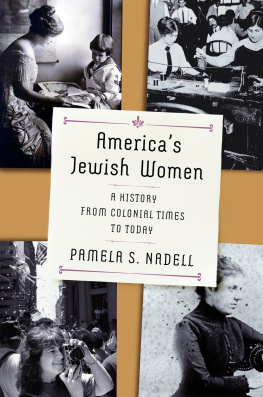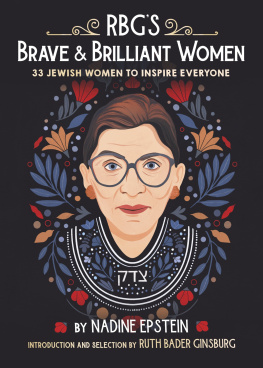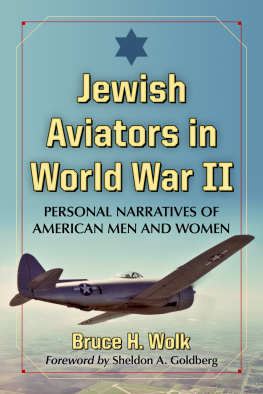
Americas
Jewish Women

Americas
Jewish
Women

A HISTORY FROM
COLONIAL TIMES TO TODAY

Pamela S. Nadell

W. W. Norton & Company
INDEPENDENT PUBLISHERS SINCE 1923
NEW YORK | LONDON
For Ed, again
I N FAMILY PHOTOS, I see Americas Jewish women changing over the years. One of my great-grandmother shows her wearing a sheitel, a wig some observant married Jewish women wear, and a black brocaded dress with a high lace collar. She was, even by the standards of the early 1900s, old-fashioned. Other photos, lining the walls of my home and cluttering my shelves, find her daughter, my grandmother, about fourteen, stylish in a white lace and cotton dress, wearing pumps with tiny bows. Another image shows my mother, in a park on a warm spring afternoon, wearing a black pencil skirt and white blouse. The baby in a bonnet she cradles is me. In more recent photos, I wear my workingwomans wardrobea black pantsuit. Digital images of my daughter sliding across my computer screen reveal a student wearing skinny jeans and tall boots.
As our clothing differed, so too did the fabric of our lives. My great-grandmother was one of the more than two million Jewish immigrants who came to America at the turn of the twentieth century. Her daughter, my grandmother, raised children in the Great Depression. My grandmothers youngest, my mother, worked as a secretary, stopped to raise a family, and later, after the children were grown, became a realtor. I, the first in my family to graduate college, rode the coattails of a revolution raising expectations for what Americas women could do and achieve. As for my daughter, what opportunities the years ahead will bring, I can only imagine.
If the past serves as prologue, then it suggests that enormous changes will define her generation as they did those of the women in my family. The homes made, the families raised, the work pursued, the politics embraced, even the games played are molded by our moment in time. The great crises of wars and economic busts, the technological marvels of each erawhether washing machines or smartphonesthe everyday occupations of feeding families and visiting relatives are woven into womens lives across the years.
Yet a singular bright thread distinguishes the women in my photos from other American women. We are not only American women. We are Americas Jewish women. For much of my life I have been mulling over these images, envisioning the stories behind them as well as the tales of the Jewish women who came before us. Americas Jewish Women: A History from Colonial Times to Today is the result.
At dinners over the years, acquaintances have bristled when I said I was writing this history. Impossible, they responded, pointing to themselves and to the other Jewish women around the table to show just how different each one was. Then they would sit back, convinced that they had proven their point, that I should walk away from this book.
But as a historian, I beg to differ. In the wake of the new wave of feminism of the 1960s, scholars began writing women into history, their contribution to advancing the status of women in American life. Few then had any inkling that Americas Jewish women had a history of their own. But three graduate studentsPaula Hyman, Charlotte Baum, and Sonya Michelpointed the way, in 1976, with The Jewish Woman in America.
Now, in the twenty-first century, Americas Jewish Women, resting on decades of scholarship, narrates the unique story of the Jewish women who, for more than three and a half centuries, have called America home. At its heart lies the assertion that Jewish women were a part of Americas women and yet, throughout history, have remained distinctly apart from them.
That these women were Jews mattered. But Americas Jewish Women recognizes that what it meant to be a Jew has varied enormously. Some Jewish women have placed Judaism at the center of their lives. Their days and years have rotated around Sabbaths and holidays and a world of Jewish rituals, organizations, and causes. Others have cared less about religion yet carried within them a powerful sense of Jewishness, the everyday experience of being a Jew. That identity shaped some of their choices about education, marriage, work, and community. For others, being Jewish was an occasional distraction. Still others denied that being Jewish had any relevance for their lives at all. They were just Americans or just women, or perhaps they called themselves by some other name. Yet across the years, some of those Jewish women too discovered that, no matter how they labeled themselves, others still called them Jews.
This history of Americas Jewish women casts its net over all these womenthe religiously observant and the fiercely secular, the needy immigrants and the savvy businesswomen, the feisty matrons and the spirited women who became rabbis. In the chapters ahead, we will hear stories of Jewish women who made homes in colonial seaports, frontier towns, urban ghettoes, and suburban streets, whose lives were most closely bound up with family, neighborhood, work, and community. We will read of weddings, marriages, and babies, of foods cooked and served, of communities built, of life in times of war and crisis and in times of peace and prosperity.
We will also discover the many whose lives, spreading over larger canvasses, left deep footprints in the history of the nation they called home. Americas Jewish Women brings to life some of those who, making their marks in different fieldseducation, politics, industry, labor, journalism, health care, charity work, popular cultureleft a legacy that reverberated across American history.
Americas freedoms, which permitted my great-grandmother to keep her wig when others discarded theirs, opened up an array of new avenues for each generation. We will meet the colonial mother heartbroken over her daughters intermarriage, the Confederate spy facing down a general, the poet of the huddled masses heralding Zionism, the factory worker taunting scabs, the Communist sending her daughter to school on Jewish holidays, the Holocaust survivor feted on national TV, the lawyer striding into Congress.
That air of freedom, its opportunities and challenges, emboldened Americas Jewish women and inspired their activism and deep commitments to changes they thought would make this world a better place. Their history became one of remarkable political engagement. In their neighborhoods, they rioted against the high price of kosher meat. Picketing outside factories, they demanded safe working conditions and a living wage. Their Jewish womens organizations campaigned against the perils of white slavery and championed Zionism. Jewish housewives combatted antisemitism. Jewish lesbians decried homophobia.
Years ago a Jewish woman asked: What is the difference between a bookkeeper and a Supreme Court justice? One generation, quipped Supreme Court justice Ruth Bader Ginsburg. This book is for the curious who want to know how that happened and who wonder about the generations of Americas Jewish women, like those in my photographs, who came before.
T wo of the nations early Jewish women stand at opposite poles of this story. The first, Grace Mendes Seixas Nathan (17521831), lived her life bound by the commonplace roles of wife and mother. The second, her great-granddaughter, the writer Emma Lazarus (184987), won acclaim for her poetry and prose. Her poem The New Colossus, inscribed on a plaque in the pedestal of the Statue of Liberty, has welcomed millions to America with the words, Give me your tired, your poor / Your huddled masses yearning to breathe free. A woman of purposeful action, she left her mark in her day and far beyond.
Next page









